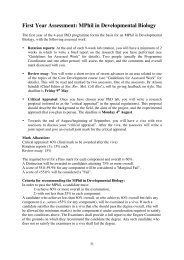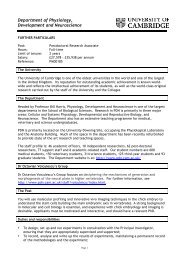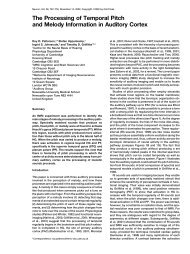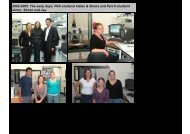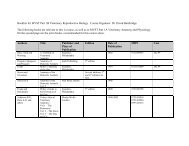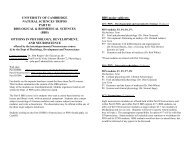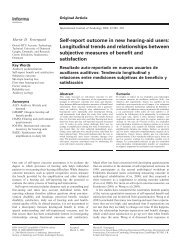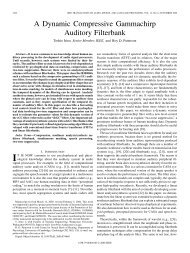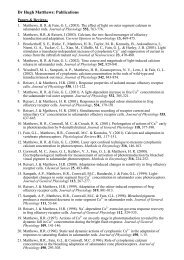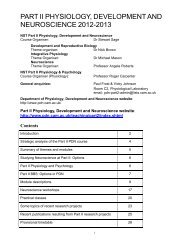FRIDAY MORNING, 20 MAY 2005 REGENCY E, 8:30 A.M. TO 12:00 ...
FRIDAY MORNING, 20 MAY 2005 REGENCY E, 8:30 A.M. TO 12:00 ...
FRIDAY MORNING, 20 MAY 2005 REGENCY E, 8:30 A.M. TO 12:00 ...
Create successful ePaper yourself
Turn your PDF publications into a flip-book with our unique Google optimized e-Paper software.
two major evaluative components, labeled Hedonic Tone and Eventfulness. Furthermore, it was found the mere presence of common<br />
sound sources, regardless of sound level, correlated significantly with these evaluative components. Technological sounds e.g., traffic<br />
noise were negatively associated with both Hedonic Tone and Eventfulness, while a positive association was found between Hedonic<br />
Tone and sounds of nature e.g., bird song, and a positive association was found between Eventfulness and human sounds e.g.,<br />
human voices. These relationships lead to the hypothesis that introduction of nature and human sounds, in combination with the<br />
reduction of technological sounds may improve the quality of soundscapes considerably.<br />
9:35<br />
5aNS4. Assessment of outdoor soundscapes in quiet areas. Mats E. Nilsson and Birgitta Berglund Inst. of Environ. Medicine,<br />
Karolinska Inst. and Dept. of Psych., Stockholm Univ., SE-106 91, Stockholm, Sweden<br />
Existing quiet outdoor areas should be preserved. Appropriate indicators and limit values are needed, which are grounded in<br />
knowledge on positive aspects of soundscapes, such as perceived pleasantness and psychological restoration. For this reason, a<br />
questionnaire study was conducted in four green areas close to a major city and in four city parks. Measured equivalent sound levels<br />
LAeq, 15 min ranged between 42 and 50 dBA in the green areas, and between 49 and 60 dBA in the city parks. Sounds from nature,<br />
such as bird song, completely dominated the soundscape in the green areas. The city-park soundscapes were more complex, containing<br />
sounds from nature, as well as technological sounds e.g., traffic noise, and human sounds e.g., human voices. In general, sounds<br />
from nature were perceived as pleasant, technical sounds as annoying, and human sounds as neutral. Between 84 and 1<strong>00</strong>% of the<br />
visitors in the green areas assessed the soundscapes as good or very good. The corresponding percentages for the city parks were<br />
distinctly lower, between 52 and 65%. The results indicate that the equivalent sound level should be below 50 dBA in order to secure<br />
pleasant and restorative outdoor soundscapes in urban areas.<br />
9:55–10:15 Break<br />
10:15<br />
5aNS5. Techniques of analysis and their applicability in the context of community noise.<br />
Schulte-Fortkamp ITA-Tech. Univ. Berlin, Einsteinufer 25, D-10587 Berlin, Germany<br />
Andre Fiebig and Brigitte<br />
There is common consent to the necessity using and combining subjective and objective data for a sufficient understanding of<br />
human perception and evaluation of noise. Moreover, a wide discussion about methodology and techniques of analysis with respect to<br />
new methods in the context of soundscape research, community noise, and annoyance evaluation is urgently needed. The presentation<br />
at hand shows a methodological discussion of qualitative data and its systematic analysis based on explorative approaches applied in<br />
two different surveys. For example, by means of the analysis a transfer from verbal evaluations based on habitual language to<br />
acoustical descriptors is possible. Furthermore, the principals and steps of the analysis of qualitative data in the context of community<br />
noise are presented. Insofar, with regard to an effective and unitized handling, options and possibilities of methods in connection with<br />
specific techniques of analysis will be discussed.<br />
10:35<br />
5aNS6. Correlation of airport noise complaint terminology with available noise metrics. Nancy S. Timmerman Consultant in<br />
Acoust. and Noise Control, 25 Upton St., Boston, MA 02118-1609<br />
In the discussion of airport noise, there is a disconnect between the language used by complainants and the acoustical terminology<br />
available to the technical community. It will be shown in what ways the complaint terminology can be described with the available<br />
noise metrics and in what ways it cannot. The complaint terminology analyzed comes from the author’s personal previous experience<br />
as noise control officer at Logan International Airport. Examples of some of these are aircraft noise is: too loud, too late, too<br />
early, unending, continuous, at the wrong time, so loud it sets off car alarms, so loud I cannot hear the TV/telephone/radio, so loud it<br />
woke me up, and annoying. Terms which are not related to noise are mentioned, but not correlated. The acoustical terminology comes<br />
from the international literature and includes the standard noise metrics as well as some more recently proposed. The airport noise<br />
metrics discussed include measures of single events maximum level, SEL, duration, signal-to-noise and measures of noise exposure<br />
DNL, CNEL, Leq. It is shown that while cumulative noise metrics are useful for planning and comparison, they correlate with<br />
complaint terminology less well than single event measures.<br />
10:55<br />
5aNS7. Explorative interviews as a tool for sound evaluation. Stephan Paul Lab. of Vib. and Acoust., Dept. of Mech. Eng.,<br />
UFSC, CxP 476 Florianopolis, 88.040-9<strong>00</strong> SC, Brazil<br />
Sound and noise evaluation needs to combine physical-measurements of sound with research on the interaction of the sound and<br />
the human being. For this kind of research qualitative techniques and especially explorative interviews, with the addressed people are<br />
appropriate as they consider the human being acting within this environment. The evaluation process refers to the basic concepts of<br />
qualitative research. Different forms of interviews, how to prepare and conduct an interview and not to forget about the discipline<br />
under investigation have to be considered. This clearly shows the requirement of transdisciplinarity including knowledge from<br />
disciplines like engineering sciences, social sciences and psychology. To obtain the required information on the subject under<br />
investigation within an interview the verbal ability of the addressed people has to be considered. The possibilities of transdisciplinary<br />
work, check of verbal abilities as well as approaches for basic standardization in interviews and the need for cultural adaptation will<br />
be discussed.<br />
2592 J. Acoust. Soc. Am., Vol. 117, No. 4, Pt. 2, April <strong>20</strong>05 149th Meeting: Acoustical Society of America 2592



